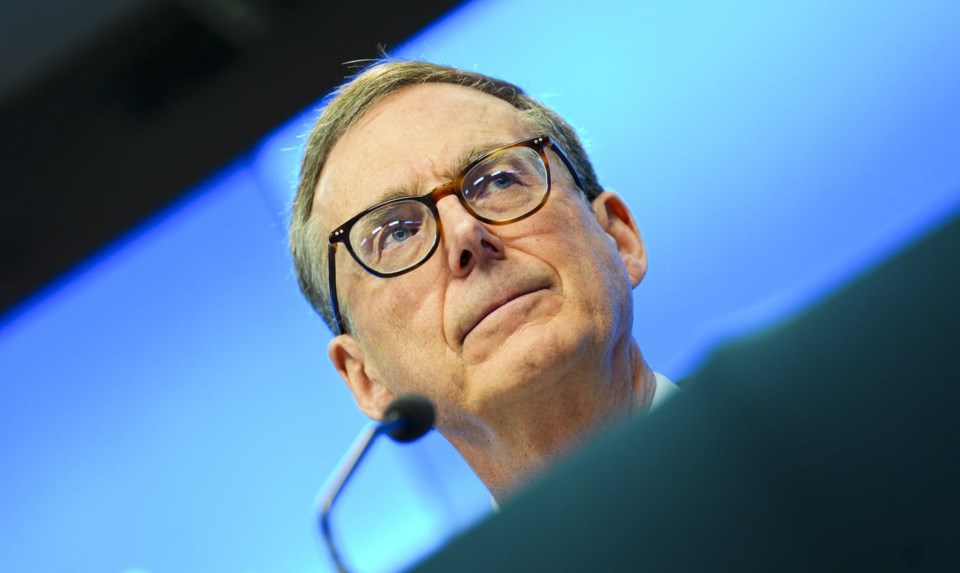OTTAWA — Few would confuse Hollywood action star Tom Cruise with Bank of Canada governor Tiff Macklem.
But while Cruise rides a plane in tailspin to his latest box office smash, some economists say Macklem finds himself in his own high-stakes circumstances with the central bank's interest rate decision on Wednesday.
Macklem's mission is to chart a path for interest rates that keeps Canada's economy afloat at a precarious moment without straying from its inflation-taming mandate.
"It really is mission impossible," said Andrew DiCapua, principal economist at the Canadian Chamber of Commerce.
The latest data show price pressures could be building up again in Canada at the same time some economists warn of a tariff-induced slowdown on the horizon, pulling monetary policy in opposite directions.
"The bank really is in a difficult position here, but they really should be resuming rate cuts to get their interest rates lower to somewhere around two per cent, again, to cushion the Canadian economy for what's to come," DiCapua argued.
The Bank of Canada's policy rate stands at 2.75 per cent following a pause at the central bank's last decision in April, snapping a streak of seven consecutive cuts. Most economists expect the central bank will hold rates again on Wednesday.
In April, Macklem said the Bank of Canada would pause issuing any formal forecasts and be less forward-looking than usual until it gained more certainty on how the economy would react to ever-shifting tariff threats.
President Donald Trump threw a new wrench into the gears of global trade late Friday when he announced plans to double existing tariffs on steel and aluminum entering the United States to 50 per cent starting Wednesday.
After Statistics Canada reported a surprisingly strong 2.2 per cent annualized rise in real gross domestic product for the first quarter on Friday, money markets were betting overwhelmingly in favour of another rate hold this week.
BMO last week firmed up its call for another hold in response to the latest economic data, now projecting a cut to instead come in July.
"The key point here is that the GDP figures are sending no obvious distress signals so far in 2025," BMO chief economist Doug Porter said in a note to clients.
But the question for some economists isn't what the economy has done — it's what comes next.
The Bank of Canada's own surveys of businesses published in early April showed sentiment was "sharply" lower amid the tariff uncertainty, with many firms putting investment and hiring plans on hold.
StatCan said the main reason Canada's economy was growing in the first quarter was because many businesses were trying to rush ahead of the tariffs, ramping up exports and stockpiling inventories.
Macklem said at the G7 Finance Ministers' Summit in Kananaskis, Alta., last month that the Bank of Canada was expecting a run-up in economic activity in the first quarter, but that the months that follow "will be quite a bit weaker."
"They're really waiting for a shoe to drop, so to speak," said DiCapua.
There were early signs of economic pain in the April jobs figures released last month, with the trade-sensitive manufacturing sector contracting by roughly 31,000 positions and the unemployment rate rising two ticks to 6.9 per cent.
A slowing economy usually takes the steam out of inflation as Canadians swap spending for saving, but April inflation data showed underlying price pressures were instead heating up.
Cutting interest rates can encourage businesses and consumers to spend — mitigating an economic hit — but also risks fuelling inflationary pressures.
"Outside of the current situation that we're in, I would say that the Bank of Canada should be holding interest rates," DiCapua said.
"But the data that we are seeing come in, especially through the labour market ... is going to move the Canadian economy into a very weak position that should keep prices at bay. So it's kind of a risky balance here."
Stephen Brown, deputy chief North America economist at Capital Economics, said he expects the central bank will deliver three more quarter-point cuts at every other decision to bring the policy rate down to two per cent before the end of the year.
"Our view at Capital Economics is that it's worth cutting again in June as insurance against those downside risks and try and protect the economy a bit," he said.
There are also "psychological" reasons for a June cut, Brown argued.
Should the Bank of Canada keep rates elevated, businesses and consumers may hold back even more on their spending decisions, which can become a self-fulfilling prophecy that weakens the economy.
"If the bank doesn't cut here, because they're still very concerned about inflation, that's telling businesses and consumers that the bank doesn’t necessarily have their back," Brown said.
CIBC chief economist Avery Shenfeld is among those calling for a rate hold this week. He said he sees the case for an interest rate cut too, but doesn't think the Bank of Canada's June decision is its final reckoning.
"No one interest rate decision in isolation would ever be a fatal error one way or the other, but I think the clock will start to tick louder on getting some interest rate relief if the economy remains soft," Shenfeld said.
This report by The Canadian Press was first published June 2, 2025.
Craig Lord, The Canadian Press



